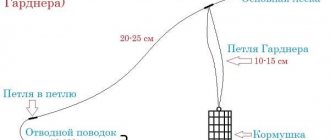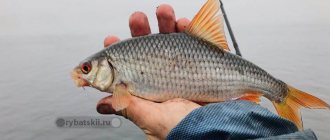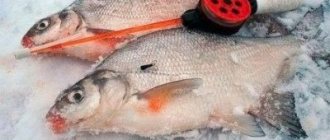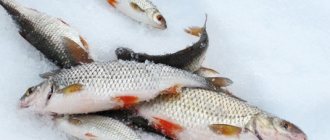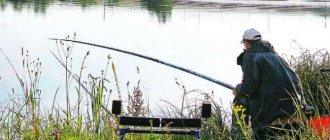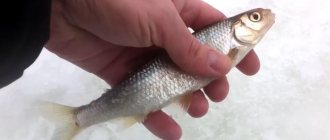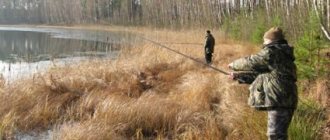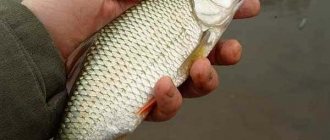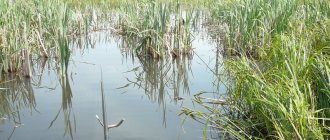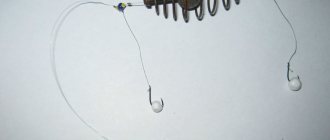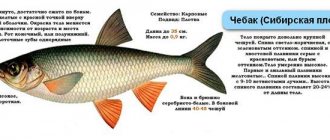When and where to catch roach
Feeder equipment is used to hunt for fish of various sizes and is successfully caught with:
- crucian carp;
- bream and bream;
- blue;
- tench;
- perch;
- carp
But the most popular fishing for roach is with a picker and feeder, which lives in large quantities in many reservoirs and actively responds to bait and bait offered by anglers almost all year round.
The roach feeds not only in the bottom layer, but also moves throughout the daylight hours in the water column from bottom to top. The English donka shows good results when catching this fish both on lakes and on rivers with rapid currents.
After the ice melts, feeders uncover their rods, because catching roach in early spring on a feeder is a “gourmet dish” for fans of bottom gear. Delicate equipment, flexible and sensitive feeders and pickers give a lot of positive emotions, which anglers miss during the long and cold winter.
Roaches do not grow to large sizes, but specimens of 300–400 grams stubbornly resist when fished and to bring them into the landing net requires both experience and skill.
The main competitor of the feeder is considered to be float tackle, but it is less catchy, as it has limitations on:
- casting distance;
- length of leashes;
- catchability in strong currents;
- the baits and baits used.
But feeder gear is used in the most difficult conditions and with its help rich catches are quite possible.
Advantages over the same float tackle:
- targeted feed supply to a given point;
- constant supplementary feeding;
- using leashes of arbitrary length and thickness;
- casting distances;
- conducting tempo fishing.
There are also advantages in choosing a location on the shore of a reservoir, because the feeder station is installed at an arbitrary point and does not require a flat coastline or comfortable conditions that floaters need.
How to catch roach on a feeder in the spring?
It is quite common to see fishermen using two or more rods at the same time. This suggests that they either use the wrong fishing technique, or they are simply unlucky with the bite, but hope does not leave them. In fact, if you catch roach using the correct method, one rod will be enough, because you need to have time to cope with it.
Conventionally, catching roach in the spring on a feeder can be divided into two steps:
- Initial feeding of the proposed fishing spot. At this stage, you need to make ten to twenty casts exactly to the place where you plan to fish in the future;
- Regular fishing. This stage involves fishing with re-casting the rod every five minutes, if there was no bite before.
Now let's break it down:
- So, the first thing you need to make sure is that spring roach fishing on a feeder is as effective as possible - in the correctly chosen bottom topography. Ideally, this should be either a flat surface or a depression, but not any rise. You can check the condition of the bottom using a weight and a float by dragging it to the bottom. On a flat surface it moves easily and without difficulty;
- Having done this, you need to unwind a line one and a half meters long and secure the rod in a position comfortable for fishing. It is not advisable to change it, so it is better to do everything efficiently the first time. Next, we begin to throw the feeder at the same point, without changing it in any way. As a reference point, you can choose some object on the opposite side of the reservoir;
- It is very important to constantly cast the feeder to the same point as before, and this must be done without a hook with a leash. We do this fifteen times. After casting with a smooth movement, preferably from behind your back, immediately fix the rod on the mount. It is necessary that the feeder always falls in the same place and is at the same distance from the tip of the rod;
- Catching roach in the spring on a feeder involves careful and thoughtful actions, the most important of which are the starting ones. These casts play a vital role; they must be performed in such a way that as many fish as possible accumulate in the chosen place. To do this, wait ten seconds after each cast and pull out the feeder with a sharp movement. This way the bait will remain in the right place;
- When the starting casts are made, you need to attach a line and a hook to the rod. We hook a maggot or worm onto it, make a careful cast to the same point and fix the rod on the holder, putting a medium tension on the line;
- If the roach does not bite on the filler for more than five minutes, check the presence of bait on the hook by pulling out the feeder. If necessary, fill it again and cast. When the fish bites, the tip of the rod noticeably reaches towards the water, then you need to make a smooth and amplitude hook, but sometimes you need to work sharply. To remove the fish from the water, continue to make gentle and smooth movements until you achieve the desired result.
Catching roach in spring on a feeder (video)
Catching roach on a feeder in spring: video
Spring roach fishing on a feeder: video from a reservoir
Fishing tactics
When catching roach on a feeder, you should take into account that this is a passing fish and attracting it to a given point is more difficult than holding it with the help of properly selected bait.
At the beginning of the session, the angler selects promising places with a hard bottom and makes a starting feeding. The bait “gathers dust”, indicating a “beacon” for fish, and with each subsequent cast, new portions of food attract fish to the bottom layer.
To select a promising location, it is not necessary to cast the tackle over a super long distance, because even in the immediate vicinity of the shore, roach is available in the required quantity.
In the spring, when the water is just warming up, coastal areas should be explored first, although at other times of the year aquatic inhabitants look for insects and other food near reeds or trees hanging over the water.
Catching roach in late autumn on a picker or feeder is also an exciting activity and decent catches, which are even filmed, happen very often. When starting fishing, it is advisable to select several points at different distances and fish them in search of fish.
In spring and autumn there is no need for large volumes of bait, the main thing is that with the help of a feeder it is regularly supplied to the fishing spot and stimulates the interest of the fish, provoking it to bite.
You don’t need to think that roach is not as cunning as carp, bream, or even crucian carp; to catch it, you also need to make a lot of effort, use special baits, small hooks and attractive baits.
If the nearby points do not bring the desired result, move to long distances, look for fish and this will bring the desired results. A pause in the bite, when large roach are being caught, means that it is time to move to a new point, and not wait until the fish comes for another portion of food.
To ensure accuracy of casting at a given distance, after selecting a point, the fishing line is inserted into a clip and this prevents accidental mistakes. When fishing for carp or grass carp on a feeder, clipping is undesirable, because when biting, the trophy will pull the rod off the stand and you should respond to it in a timely manner.
Roach does not create such problems and when fishing for it, clipping helps to keep the same distance regardless of the strength of the wind, current or other factors, and the fish is simply not able to pull the rod.
Some fishermen use marker rubber to record the required distance. This decision has the right to life, but it is more like reinsurance in case a trophy fish is accidentally caught on the hook.
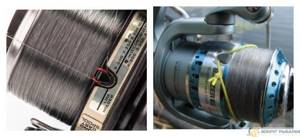
When purposefully fishing for roach on a feeder, no additional reinsurance is required and clipping is sufficient to fix the fishing distance.
Feeder gear for spring roach fishing
In order for roach fishing on a feeder in early spring to be a great success, you need to carefully select all the gear:
- Rod. The most suitable option is a feeder rod, the length of which is 390 cm. Thanks to it, you can easily throw a hook both close to you and over a decent length (sometimes even over a hundred meters);
- Coil. The most optimal choice, suitable for almost every feeder rod, is an inertia-free reel, the spool size of which does not exceed 2000-3000;
- Fishing line. Monofilament fishing line of any color, 0.2 millimeters thick, is suitable.
Choosing feeder equipment for spring roach fishing
Considering the small dimensions of the roach, we can conclude that equipment with a self-cutting function is not suitable for us. Even a relatively large roach will not be able to pull the feeding weight and send a signal to the fisherman about biting. You will have to choose some other equipment that will be quite sensitive compared to the feeder weight.
In this case, the Gardner paternoster is an excellent choice. This is an excellent equipment for a feeder, which will allow you to feel even the slightest sign of a bite. The kit includes only a hook, loops and a feeder, thanks to which it weighs minimally and sensitivity is at the highest level.
Fishing rod
Roaches are caught mainly at short distances, up to 60 meters, so for fishing on a still body of water, a rod with a length of 3.6-3.9 with a weight of up to 90 grams is selected. When fishing on a river with a strong current, use a rod with a weight of up to 120 or even 150 grams, it all depends on the expected weight of the feeders that are used in the rigs.
A heavy river rod is inconvenient for fast fishing, as a result of which it is used only when there is an urgent need for it. For short distances, it is enough to take a picker with a dough of up to 60 grams, and use feeders of the appropriate weight.
Specific models of rods are presented in fishing stores; as for manufacturers, Drennan, Preston, Daiwa are known in the best way in the feeder world. Our Volzhanka-type fishing rods are inferior in quality to branded models, but they have advantages and are relatively low in cost.
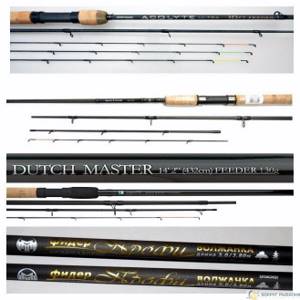
As practice shows, it is better to immediately purchase a high-quality feeder or picker so that it will last for several seasons. Changing equipment is a normal process for every fishing enthusiast, but savings should not be forgotten either.
It is more difficult for a novice feeder to immediately choose the most convenient form, so it is better to consult with experienced fishermen and make the right choice. Most fans of feeder fishing have several rods of varying lengths and power in their arsenal, which allows them to have convenient equipment in any situation.
Feeder rig for roach in spring
There are a lot of roaches in the reservoir, so choosing a place is easy - this fish is found almost everywhere. Therefore, we also choose a point based on the convenience of tempo fishing, and not just on the presence of fish. Active roach will still come for bait. The most comfortable option is fishing with a light picker at close range. If there is no current or it is weak, we use light feeders up to 20 grams.
It is better to use thin 0.1 mm braid on the picker - rigid equipment better records bites. We equip the picker tackle for roach with the softest quivertip, and we pull it fully during fishing - if necessary, we reel it in a little with a reel. When catching large roach on braided lines with thin leashes, we add a feederham insert to the rig for shock absorption and easier fishing.
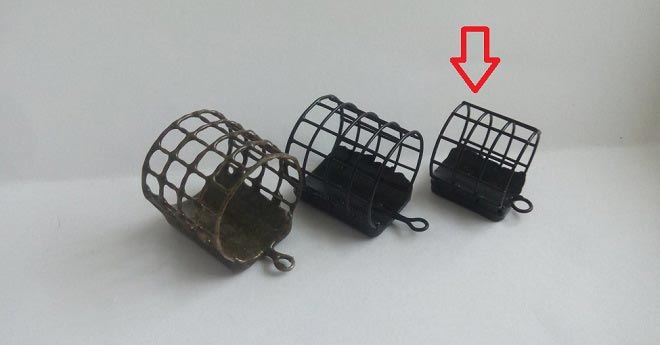
At closer distances, under the shore at 10-15 meters on the feeder, you can use a monofilament as the main fishing line with a diameter of 0.16-0.2 mm (the maximum weight of the feeder for 0.16 mm is 20 grams). Such light tackle is easy to work in the spring in a tempo style and is in no way inferior to a float in efficiency in the process of coastal fishing for roach.
At distances over 30 meters we use light and medium rods with appropriate equipment. For a long distance, especially on a current, you will need a heavy river boat from 3.9 meters with a dough of 90 grams. The main fishing line for roach at long feeder distances is only a fence. With thin braid we use a shock leader for long casts. Article about the features of feeder equipment:
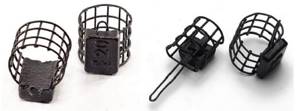
Fishing from the bottom
Installation of feeder equipment for roach in the spring can be bottom-based or for fishing with a slowly sinking bait. You can use any usual feeder installations - paternoster, Gardner loop, symmetrical or asymmetrical loop, inline running with or without a tap. To the installation we attach a leash 0.08-0.12 mm long 70-120 cm and a hook with a long shank and straight hook, No. 18-16 for bloodworms or 16-14 for other baits. Hooks – Owner, Gamakatsu and the like, but not fakes, especially at long distances. The realization of a bite over long distances is directly determined by the grip and sharpness of the hooks. More information about different feeder installations:
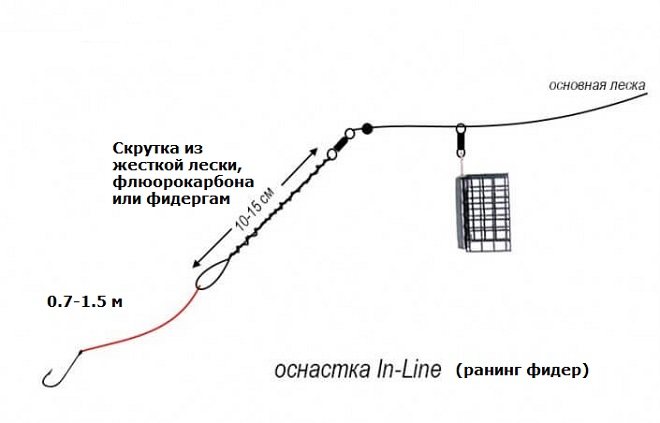
Fishing with a falling bait
In order for the bait to sink in the depths for a long time, you need to lengthen the leash as much as possible, use light thin hooks and a small nozzle. This fishing option is only possible on the current. The best setup for this is a helicopter and two nodes. In such equipment, there is no thick heavy bend on the leash, and the hinged attachment of the noose to the base saves from overlaps. More information about the equipment of a helicopter and two units:
https://rybafan.ru/fiderist/osnashhenie/osnastka-vertolet-dlya-fidera
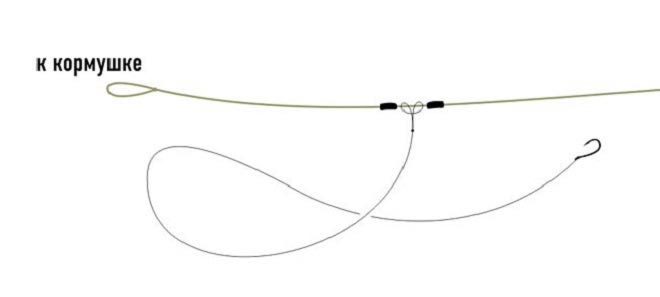
Helicopter
The length of such a leash is limited only by the casting ability and the length of the feeder. On river boats 3.9 meters or more, you can safely install leashes about 2-2.5 meters long. Additionally, you can add buoyancy to the leash by attaching foam or frozen maggots to the hook. This installation lowers the bait to the bottom for 3-5 minutes, depending on the strength of the current. This is quite enough for the roach to find and grab the bait. With such a tackle, you can catch a roach in the spring on a feeder even in very muddy water conditions, making twitches and pull-ups, during which the hook on the leash dances in the water, and the fish notices the bait better.
Subscribe to the channel:
YouTube channel RYBAFAN
We are VKontakte
Coil
Roach fishing is carried out at short and medium distances, so there is no need to use a reel with a large spool and a size of 3000-4000 will be enough to ensure comfort during the session.
Those who want to reel out tackle faster take reels with larger spools, but they are heavier, and with frequent recasts they increase physical stress. In this kind of roach fishing, the requirements for the reel are less stringent than in carp fishing, so the angler should be guided by his own preferences.
Feeder fishing for roach
Main features of feeder fishing for roach:
- Tempo fishing on a hard bottom with constant feeding in small portions.
- Loose, dusty consistency of bait. The mixture should not contain large particles that will distract the fish from the bait.
- In spring, roaches move to the feeder better, especially during the pre-spawning migration period. In early spring, in large and medium-sized reservoirs, the roach stands at a sufficient distance from the shore - you can’t reach it with a float. And here is the right place for the feeder. Regular donks are too rough for accurate bites.
- When fishing, we use thin long leashes, small hooks and baits.
- Often, especially in spring, roaches take the falling bait rather than from the bottom. You can also achieve such animation with a feeder, but with ordinary tricks this is problematic.
- Important points of tactics in the spring are the correct choice of point and constant non-stop feeding. We support a cloud or tail (on the current) from food particles. Dirty always attracts roaches.
An article about catching roach with a feeder.
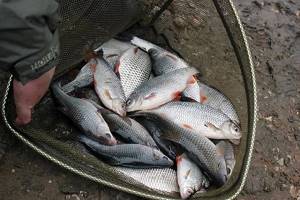
Line or cord
When catching cautious fish, such as roach, you need sensitive gear that allows you to clearly see the bite. There are no “steam locomotives” on roach, this is not trophy carp fishing, and to register sluggish and weak bites, it is recommended to use a cord rather than a monofilament line.
The stretchability of the fishing line is a negative factor, and the greater the distance, the longer the monofilament base stretches. A thin cord with a diameter of 0.1 - 0.12 mm does not frighten wary fish, especially if you choose a color that increases camouflage. In a current, a thin base is also more advantageous, because it does not create strong resistance, which allows you to use less heavy feeders.
The weight of the feeder plays a big role in increasing the sensitivity of the gear, and it is advisable to reduce it as much as possible. In this case, there is a direct relationship between the thickness of the base, the weight of the feeders used and the sensitivity of the entire gear. The non-stretchable cord instantly detects the bite and all that remains is to hook the fish and deliver it to the shore.
Leashes
But it is advisable to knit leashes for catching roach from fluorocarbon fishing line, which has the maximum possible camouflage. Of all the leader materials now available to feeder anglers, fluorocarbon (or fluorocarbon) line is the least noticeable in clear water.
The invention of fluorocarbon is associated with military developments, but manufacturers of fishing equipment quickly appreciated all the advantages of the progressive material and found the opportunity to use it for the manufacture of fishing line and leader materials.
Monoline is stronger than fluorocarbon line, but even thicker fluorocarbon benefits due to the fact that it is invisible in water. When fishing for roach on monofilament leashes, its thickness is 0.08-0.12 mm, but fluorocarbon 0.14-0.16 will be less noticeable even in absolutely clear water .
Another advantage of fluor is its rigidity and abrasion resistance. When fishing on a silty bottom, these factors are not critical, but when fishing on a complex bottom surface with shells and stones, the abrasive properties of the leader material play an important role.
In feeder fishing, high consumption of leashes is common and there is no point in saving on this. But in competition conditions, when every minute counts, saving time on tying leashes helps to win prizes, and in this regard, fluorocarbon leash materials provide advantages.
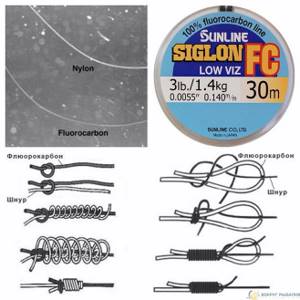
The length of the leash is variable and varies from 15-20 cm to one and a half meters and above. When fishing in the current, the leashes are made longer, and when the bite is inactive, they are lengthened even more, and this often gives the desired results.
In a pond with stagnant water, the feed is not carried away by the current away from the feeder, and to ensure the location of the hook with the nozzle near the feeder, the leashes are made shorter.
There are no strict recommendations regarding the length of the leash, and this factor is determined empirically.
Do not rely only on the fact that someone has successfully fished with leashes a meter or one and a half long, because the conditions are different on each fishing trip, and roach is a timid fish and it is advisable to put it to sleep.
Inconspicuous leader material and a long leader help camouflage the equipment, and the likelihood of a bite increases significantly. The leash should be changed after it begins to curl and loses its physical properties.
Roach in spring
In spring, all these principles also work, and they must be strictly followed. At this time you can catch large, migratory ram, roach, chebak, and sorog. If in summer this fish can be caught at a slower pace, in a wait-and-see manner (large specimens), now the key to success is constant recasting and feeding the point. The roach is active in the spring; it eats a lot so that it has enough energy to recover after winter and travel to the spawning bays. However, in a particular unit of time, it cannot consume much food at a time due to its small size and eggs in the body cavity. Therefore, in the spring it is important not to overfeed the fish, but simply keep it at the point.
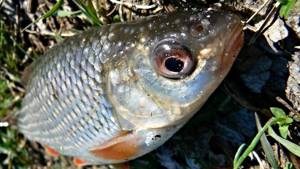
Early spring
Feeder fishing for roach in early spring can be started on thawed areas in the ice, if they exist in places where this fish stays or accumulates. Usually these are holes with an average depth of 3-5 meters, under the edges, on shells and hard areas with uneven surfaces. In large rivers and reservoirs, migratory ram and roach accumulate by March at the entrances to the mouths of small rivers and the boundaries of depth and shallows in bays, as well as near the edge of last year's vegetation, if there is 2-3 meters of water.
The roach feeds in the spring, but cannot yet move for a long time and a lot - migrations are step-by-step, travel is a long rest. Therefore, we look for local fish in winter places where they were caught in February, if there is already no ice there. We catch migratory schools in estuary bays or lower sections of tributaries. Usually these are exits from pits with edges and other underwater shelters. The roach will not stand too deep, but it still has nothing to do in the shallows.
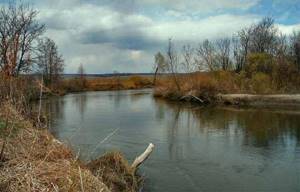
After the ice completely disappears, the flocks become more active and become larger. At this time, you can find roach in quiet, well-warmed areas in good warm weather. In bad weather in spring, you need to look deeper, near parking areas. Gradually the water becomes cloudy and begins to warm up. At the same time, the local roach disperses into shallower water areas, and the migratory roach begins to rise upstream of the tributaries. The best places for fishing in mid-spring are small rivers and the coastal zone (on large bodies of water), level tables near the shore with vegetation, shelters and a smooth current. The roach loves sand; it can rarely be found on mud. On small rivers in the spring we fish close to the shore, under the edge of the riverbed below or above the rifts, in hollows under cliffs - we check as many promising places as possible.
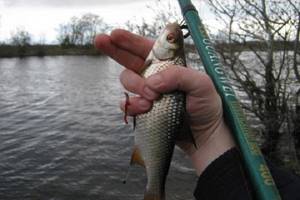
April May
When the water warms up to 8 degrees, the roach is absolutely active. Fish dart around the water area in search of food, and migratory schools move upward, stopping to rest in convenient places. At this time, active fishing with a feeder begins. If fishing in early spring cold water was, as they say, just to take your breath away and catch at least a dozen, now you can catch a cage of large, selected roach. Catching roach on a feeder in April with the beginning of water warming and an increase in its level in reservoirs - full-fledged search fishing, feeding the found points, tempo recasts every 2-3 minutes, experiments with baits and the length of leashes.
Periods of no biting in the spring alternate with successful days, gradually developing into a pre-spawning feast. At this time, male roaches develop rough bumps on their head and back. At the end of April - May, roaches spawn in water meadows and in the upper reaches of rivers, hiding their eggs from predators in larger reservoirs. The hatched larvae are carried downstream into larger bodies of water.
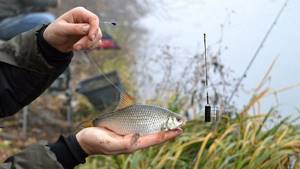
A week before spawning and the same amount after it, the roach does not bite, but after spawning, with the beginning of the specific May warming, the bite resumes with renewed vigor. And at this time, not only the worm, bloodworm and maggot, but also barley, wheat and corn begin to work. You need to look for roach with a feeder in late spring in calm places with a hard bottom not far from vegetation, coastal or underwater. In May, even in small rivers, there is a high chance of catching trophy specimens that entered in early spring from large arteries or reservoirs.
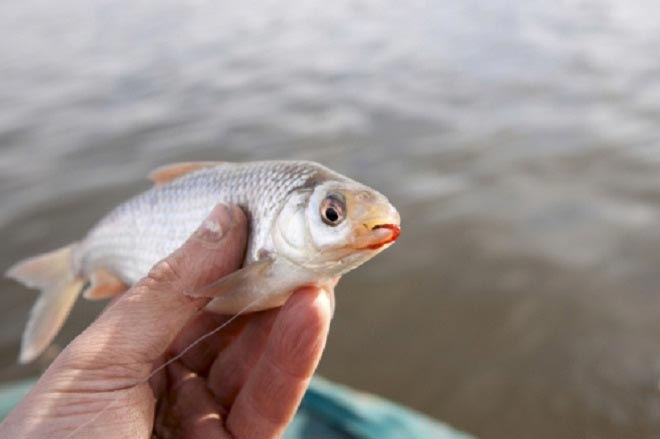
Hooks
The hook for roach is selected with a spatula, small and sharp, since when the bait touches the lips, the fish should be hooked. The hook size when fishing in clear water is number 16-18 according to the European classification; if conditions allow and the baits are larger than bloodworms or maggots, larger hooks number 14-12 are used.
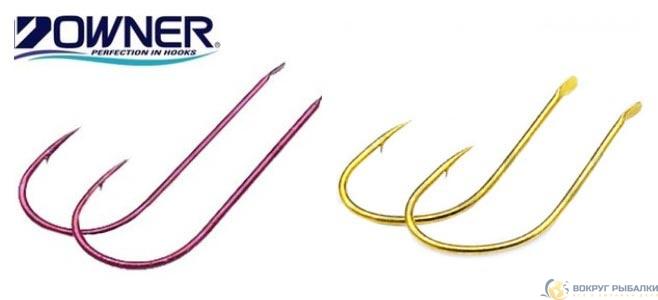
Few people take into account that roach responds well to canned corn and this is one of the best baits for this fish. We are more accustomed to the fact that bream or crucian carp bite well on sweet corn, but large roach also like this bait, so with its help you can significantly increase your catch.
Another thing is that you don’t need to fish with sweet corn right away, but only after the place is fed and the fish come to it.
Initially, bloodworms, worms and maggots are used as bait, because animal baits are preferable for roach at any time of the year. After the fish becomes active and lingers near the food, the bait is enlarged in order to enlarge the catch, and in most cases this is successful.
Pressed canned corn is also added to the bait so that the fish get used to its aroma and are not afraid of the bait.
An important point is the color of the hook, because it has been noticed that roach reacts more actively to light and red hooks and takes the bait more confidently. A box with hooks does not take up much space in your arsenal, so you need to have some choice.
In some cases, red hooks work better, but there are fishing situations when golden or white ones become catchy, so it’s better to take several varieties with you and decide on the spot which one works best on this day and on this body of water.
Roach activity in different periods of spring
Catching roach on a feeder in early spring has significant differences from fishing for this fish at the end of the season.
Early spring
In March, most of the reservoir is still covered with ice, so catching roach with feeder gear at the beginning of the season is only possible on ice-free rivers and canals. In cold water, the life processes of the sorog proceed slowly, so its feeding activity is at a low level.
In the spring, roach behaves extremely cautiously and refuses to take bait presented on rough equipment. The bite is greatly influenced by:
- Atmosphere pressure;
- transparency and water level;
- the strength of the current.
Regular bites are expected only if the barometer stays at the same level for several days. Roach's appetite increases during prolonged thaws.
Heavy precipitation in the form of sleet or rain can affect water clarity and cause a lack of bite. The opening and closing of river locks, leading to changes in water level and current strength, also affect the activity of the sorog.

In early spring, you can count on a stable bite only in places where warm waters are discharged. In such areas there is constantly an accumulation of bloodworms and other invertebrates, which form the basis of the roach’s food supply.
April and May
With the arrival of April, the situation does not change dramatically. At the beginning of the month, a stable roach bite on the feeder is observed only in reservoirs in the southern regions.
In the middle zone, the sorog begins to delight anglers with frequent bites only towards the end of April. 2–3 weeks after the ice melts, roach bite well in the coastal zone of lakes and reservoirs. The fish feeds in the middle layers of water and prefers baits of animal origin:
- maggot;
- bloodworm;
- caddisfly;
- bark beetle;
- to the worm.
Severe turbidity of the water at the end of April does not make it possible to successfully fish on large and medium-sized rivers. However, in the middle reaches of small rivers the bite is quite good. The bulk of roach at this time is in coastal pools and bays. It is almost impossible to catch a sorog on the riverbed.

In May, even a novice feeder can count on a good roach bite. When the water warms up to 15 degrees, its flocks enter the coastal zone and begin to spawn. While some individuals are spawning, others are feeding intensively. Peak fish activity occurs during the daytime . By the end of the month, the sorog moves to deeper areas, and its feeding activity decreases.
Feeders
The choice of feeder for roach depends on the fishing distance, the viscosity of the food and the activity of the fish. The starting feeding is done using 5-10 large feeders, and then fishing is carried out at an active pace and with each cast of the tackle, a new portion of food is sent into the water.
On the river, metal mesh feeders are more convenient, creating little resistance to the flow and at the same time quickly “giving away” the bait. It is more convenient to hammer in a metal mesh and the current is less likely to carry away a splashed-down feeder. Such feeders have a covered bottom area and they descend in the water column in a certain way.
The presence of lugs ensures good contact with the bottom and helps keep the feeder at a given point.
At long distances, bullet feeders that have a ball-shaped weight at the bottom and have excellent aerodynamic properties are effective.
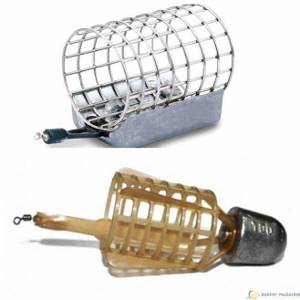
Important! When roach are actively biting, less food-intensive feeders are chosen, and sometimes they are not even clogged with bait. The activity of the fish indicates that there is enough food at the point, and you really wouldn’t want to overfeed it.
Bait for spring roach
When a section of the reservoir has been selected and the fishing rod is set to “five”, it’s time to start baiting. Some uninformed anglers may argue that it is not so necessary when fishing - it is better to immediately avoid further conversations with such people. This product should be a must-have for a fisherman, so you can buy it at a fishing store or prepare it yourself.
Making bait for roach with your own hands at home:
Since the roach does not disdain food, bait is made from ingredients that include:
- various cereals (barley, semolina);
- bread crumb;
- makukha;
- breadcrumbs;
- birdseed;
- flavorings.
Those who don’t like to prepare their own bait can always buy specialized bait in fishing stores. The most popular of them:
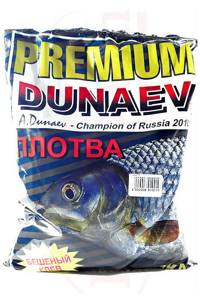
Dunaev Premium – roach Traper – Ploc
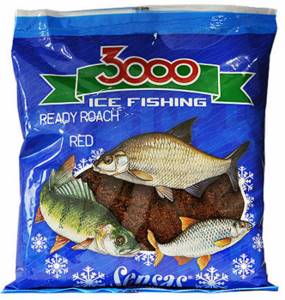
Ice fishing, Sensas 3000 roach
Fishermen have long noted that only well-prepared bait can keep a school of roach in one place. And keeping ground crackers with finely chopped maggots and dry milk will be an excellent snack for this fish.
Recipes tested by us:
To prepare bait at home, you will need:
- Boil 200g of millet cereal for 10-15
- Cut maggots 50g;
- Add 200g bread crumb;
- 100g birdseed;
- Roll the mixture in 200g breadcrumbs;
- 50g of anise or honey per 1 kilogram of bait for viscosity.
Divide the prepared mixture into medium-sized balls and pack them in a container. Before fishing, we recommend adding a little soil to the bait from the reservoir where fishing will take place.
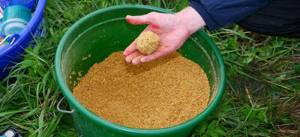
Having measured the depth of the reservoir, you need to make a couple of casts of the resulting mixture at one point. After half an hour, you can start fishing, not forgetting to gradually feed the fish in small quantities.
As another recipe for preparing bait, fishermen collect ingredients such as:
- Breaded crackers – 300g;
- Ground rolled oats – 100g;
- Grated garlic – ½ tbsp;
- Hemp seeds – 50g;
- Vegetable oil – 50ml;
- Maggot - half a matchbox.
The mixture is prepared in this way: ground rolled oats are rolled in breadcrumbs and seeds, then sprinkled with garlic and maggot. Vegetable oil is added to make the bait sticky. You can add biscuit, anise or salt and sugar as a flavoring. On a pond, it is best to add a little clay to the bait and gradually feed the fish, making sure not to overfeed it.
The only ingredient that should not be in bait is vanillin. Its bitter taste repels roaches.
Another recipe for preparing bait for peaceful fish, including roach, video:
Installation of equipment
When choosing equipment for catching roach, take into account the fact that self-cutting rigs are useless. A small fish is not able to lift or move a heavy feeder, so hooking the angler is necessary in any case.
The feeder is not involved in hooking the fish, and this responsibility falls on the shoulders of the fisherman. The installation should be such that the quiver tip of the rod instantly reacts to a bite and signals the angler about his further actions.
Sensitive equipment are:
- Gardner loop;
- paternoster;
- sliding installation.
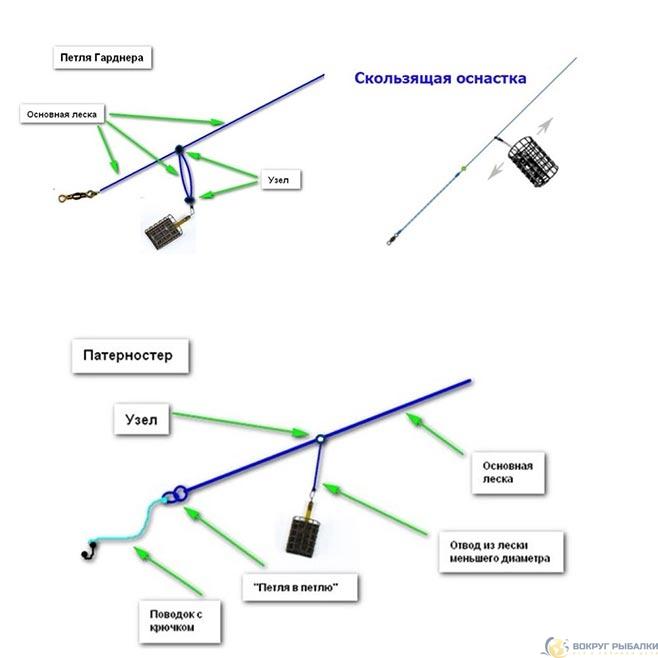
We recommend using a Gardner loop, which is knitted directly on the main cord. To make such an installation it will take only a few minutes, so there is no point in preparing it in advance, even when fishing with a cord.
The installation is reliable and sensitive even in strong currents, and this is its advantage over other feeder installations. And in cases where you have to fish in a reservoir with a muddy bottom, the installation of a Gardner loop, or a paternoster very similar to it, is simply irreplaceable.
When knitting a Gardner installation, a swivel with a quick release is inserted into the loop, allowing, if necessary, to quickly change feeders without tying up the equipment.
